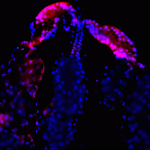Link to Pubmed [PMID] – 20862317
PLoS Pathog. 2010;6(9):e1001112
Many genes involved in the immune response of Anopheles gambiae, the main malaria vector in Africa, have been identified, but whether naturally occurring polymorphisms in these genes underlie variation in resistance to the human malaria parasite, Plasmodium falciparum, is currently unknown. Here we carried out a candidate gene association study to identify single nucleotide polymorphisms (SNPs) associated with natural resistance to P. falciparum. A. gambiae M form mosquitoes from Cameroon were experimentally challenged with three local wild P. falciparum isolates. Statistical associations were assessed between 157 SNPs selected from a set of 67 A. gambiae immune-related genes and the level of infection. Isolate-specific associations were accounted for by including the effect of the isolate in the analysis. Five SNPs were significantly associated to the infection phenotype, located within or upstream of AgMDL1, CEC1, Sp PPO activate, Sp SNAKElike, and TOLL6. Low overall and local linkage disequilibrium indicated high specificity in the loci found. Association between infection phenotype and two SNPs was isolate-specific, providing the first evidence of vector genotype by parasite isolate interactions at the molecular level. Four SNPs were associated to either oocyst presence or load, indicating that the genetic basis of infection prevalence and intensity may differ. The validity of the approach was verified by confirming the functional role of Sp SNAKElike in gene silencing assays. These results strongly support the role of genetic variation within or near these five A. gambiae immune genes, in concert with other genes, in natural resistance to P. falciparum. They emphasize the need to distinguish between infection prevalence and intensity and to account for the genetic specificity of vector-parasite interactions in dissecting the genetic basis of Anopheles resistance to human malaria.

